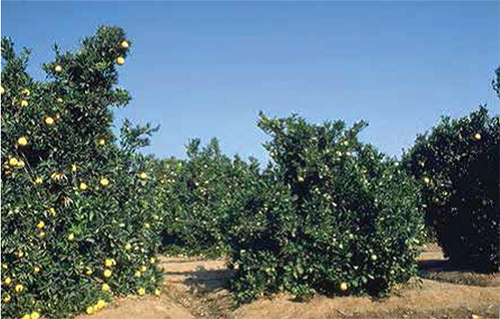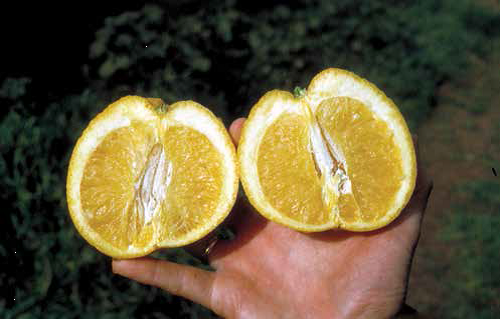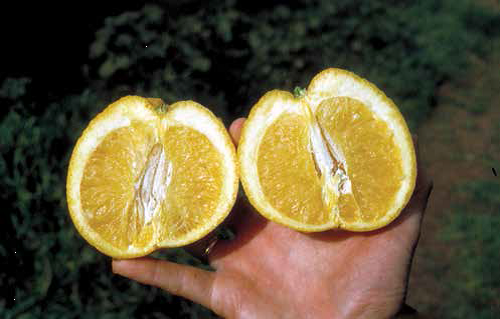Citrus Stubborn Disease Pest Profile
Pest Profile

Small Valencia orange leaves showing curled and abnormally small leaves due to stubborn disease. (Photo above by Robert G. Platt.)
Description
Citrus stubborn disease (CSD) is caused by a bacterium without a cell wall and affects citrus plants. The bacteria are found in the phloem sieve tubes of infected plants. The bacteria multiply in the vector, usually leafhoppers, and are transmitted to the plant when the infected leafhopper feeds. Spatial and temporal analysis shows there is mostly primary spread from weeds to citrus with very limited or secondary spread of citrus to citrus. Even after infected trees are top worked and grafted with healthy budwood, the symptoms persist, hence the word “stubborn” in the name.
History and Distribution
CSD was first reported in California in 1915, however, it took decades before it was determined to be an infectious disease. Obligate, fastidious, phloem-limited spiroplasmas are difficult pathogens to work on. Isolation and culturing of S. citri is technically demanding and time consuming. The pathogen is typically low in titer (concentration) and unevenly distributed in trees, making reliable detection challenging.
CSD is found worldwide, including Africa, Asia, Europe, and North America. It is widespread in temperate regions with arid or semi-arid climates where citrus is typically grown with irrigation, due to limited rainfall. CSD has been identified in some of the largest citrus growing areas within California, with higher prevalence of the disease in areas near the foothills such as those located in Kern, Tulare, and Fresno counties.
Hosts
Natural weed hosts of CSD are periwinkle (Vinca spp.), wild radish (Raphanus sativus), London rocket (Sisymbrium irio) and many Brassica spp. While all citrus may be affected, those primarily affected are sweet orange, grapefruit, and tangelo trees. Lemons, limes, and trifoliate hybrids seem to be more tolerant to CSD.
Vectors
The most common vector of CSD is the beet leafhopper (Circulifer tenellus), found in the citrus growing portions of California. The leafhoppers contract the bacteria while feeding on infected weeds and remain infected for life, transmitting the bacteria to citrus and other plants as they feed. Very little secondary spread from citrus to citrus has been observed. Grafting or using budwood from infected plants can also spread and transmit CSD. Seed transmission does not occur.
Symptoms
Many of the symptoms of CSD look like those of other common citrus diseases, such as Citrus Tristeza Virus, Huanglongbing or even nutrition deficiency leaf mottling, similar to zinc deficiency. Freeze damage, insect damage, and poor tree nutrition also cause similar visual symptoms. All these variables make field diagnosis of CSD difficult. Positive identification of CSD often requires laboratory testing.
Leaves are often smaller and tend to grow upright, close to the stems with curled leaves. If young trees are infected, stunted growth and low fruit production are common throughout the life of the tree. If the trees are older, they often have low yields and fruit drop. Some older trees remain symptomless, while others may only have a portion of the tree or a branch showing symptoms, as CSD does not spread very well within a tree. Off season flowering can occur, which can lead to fruit of varying maturity on the affected tree or portion of the tree. Fruit that is produced will likely be small, can be lopsided, acorn shaped, and may have a bitter flavor. Seeds within the fruit are frequently aborted early in their development and will appear small and dark in color.

(Photo credit: UCANR blog; stunted canopy size due to CSD.)

(Photo credit: UCANR blog; misshaped fruit caused by CSD.)

(Photo credit: UCANR blog; discolored citrus seeds caused by CSD.)
Economic Importance
When trees are affected by CSD it can have a significant impact on production and marketability of the fruit. Lower yields, lower crop value with higher input costs, and potentially loss of markets due to quarantines all may lead to a high economic impact of CSD.
References
- Agriculture: Citrus Pest Management Guidelines Stubborn Disease. (2019, January).
UC Statewide IPM Program. Retrieved May 21, 2021, from https://www2.ipm.ucanr.edu/agriculture/citrus/Stubborn-Disease/. - Brown, L. G. (1992). Stubborn Disease of Citrus. Plant Pathology Circular No 351.
https://www.fdacs.gov/content/download/11358/file/pp351.pdf. - CABI. (2020, December 11). Spiroplasma citri (stubborn disease of citrus). Invasive Species Compendium. https://www.cabi.org/isc/datasheet/50977.
- Citrus stubborn disease (CSD). (n.d.) Citrus Diseases. Retrieved May 21, 2021, from http://idtools.org/id/citrus/diseases/factsheet.php?name=Citrus%2Bstubborn%2Bdisease%2B%28CSD%29.
- Citrus Stubborn Disease Spiroplasma citri. (n.d.). Plant diseases.org. Retrieved May 21, 2021 from https://www.plantdiseases.org/sites/default/files/plant_disease/narratives/7.pdf.
- Faber, B. (2016, March 29). Distorted Fruit and Mottled Leaves? Topics in Subtropics. https://ucanr.edu/blogs/blogcore/postdetail.cfm?postnum=20624.
- Mello, A., Yokomi, R.K., Payton, M. E., & Fletcher, J. (2010). Effect of Citrus Stubborn Disease on Navel Orange Production in a Commercial Orchard in California. Journal of Plant Pathology, 92(2), 429–438.
- Rangel, B., & Krueger, R. (2013, March 15). Stubborn Disease of Citrus in California https://ucanr.edu/blogs/blogcore/postdetail.cfm?postnum=9392.
- Trimmer, L. W., Garnsey, S. M., & Graham, J. H. (2000). Compendium of Citrus Diseases (2nd ed.). American Phytopathological Society.
